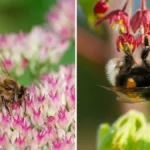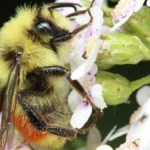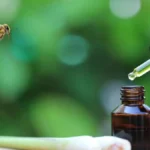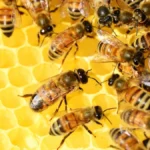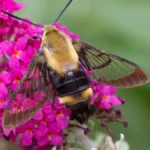In this article, we will look at how to make bumblebees go away without killing them. If we cannot make them go away, then we will look at how to remove them, and finally, once we have got rid of them, we need to look at how to stop them from coming back.
What is a Bumblebee?
A bumblebee is a big, clumsy bee that is, for want of a better word, more bumbly than a honeybee. Bumblebees live in small seasonal nests or colonies.
How are Bumblebees Different from Honeybees?
Honeybees make beeswax which melts at 144 to 147 °F (62 to 64 °C). Unlike honeybees, bumblebees have more primitive wax technology and make wax that melts at 86 to 104°F (30 to 40°C). This primitive wax has limited the bumblebees in many ways – it does not allow them to get over the equator as an example. Their range is limited primarily to colder places.
A bumblebee nest can also not survive a winter. The nest starts in spring when a queen bumblebee who has hidden in a safe place to survive the winter emerges and makes a nest. She collects pollen, collects nectar, and raises her first young, who will then work with her to make the bumblebee nest stronger.
At the end of a season, a bumblebee nest will comprise between a handful of individuals up to 400 or so in exceptional conditions. This pales in comparison to honeybee colonies which can achieve populations of 50 to 60 000.
Why We Should not Kill Bumblebees?
All bees on Earth are suffering from our presence on the planet. Poisons, environmental destruction, big ugly cities, and pollution are just a few of the things we have created which damage bees. Bees pollinate crops, and without crops, we will not be able to eat. Bees also pollinate wildflowers and things that other animals eat, and allow natural plants to reproduce and clean the air and water for us. Without bees, our world will be very ugly and unhealthy.
If we compare a bumblebee to a honeybee, the easiest way to do this is by way of an analogy. Imagine a kid’s toy drone compared to a helicopter. When the helicopter lands it blows everything all over the ground, whereas the kid’s toy drone just makes an annoying buzzing noise.
Pollination
When a bumblebee lands on a flower it is like a helicopter and just blows pollen all over and pollinates things with its bumblishness. A honeybee on the other hand buzzes in and collects nectar and is a way less effective pollinator. For many flowers, a single bumble visit is enough to be pollinated, whereas ten or more visits by a honeybee are needed.
Bumblebees are essential pollinators, and their numbers are in serious decline. If we have a nest, we want to either help it get the hint to move or help the nest move. Ideally, we want to encourage them to go somewhere where they do not cause a problem.

Why Bumblebees Always Come Back
I perform honeybee removals all the time. People always ask “Why do the bees come back?”. This is much like asking people why they came back to their cities after they were bombed flat in WWI and WWII. The cities are in the right place. Even if the same people do not come back, different people will find that spot.
Bumblebees choose nests to be close to resources. If you have flowers, you will attract bees. Simple. So the best strategy is to create places for bumblebees to live where they do not cause you problems. In this way, you get your ecosystem services (pollination and fruit) and they get to make a living and do their thing.
How to Make Bumblebees Go Away?
What we are really saying is how do we get bumblebees to go somewhere else. The best time to make bumblebees go away is before they build a big nest. A bumblebee nest is a colony consisting primarily of mothers and their babies. Mothers just don’t leave babies – no matter what species. If you notice bumble bee activity in a clump of grass, your compost maker, or hedge, chase them away before they have lots of babies.
Smelly Harmless Sprays
The easiest method to make bumblebees leave is to sprinkle smelly substances on the nest. Dilute vinegar solution, or citrus oil in water work well. The smell confuses the bumblebees and they leave. Some people use cinnamon sprinkled on the hive – I find this idea wasteful as cinnamon is harvested at a significant cost to the environment.
For the vinegar or citrus oil-water mix, get an old sprayer bottle that had some household product in it. I personally like old bleach sprayers as the mechanisms are robust to deal with the bleach. Rinse it well and mix a 50/50 solution of spirit vinegar and water. Alternatively, a few drops of citrus oil in a cup of water and shake vigorously.
When to Spray the Smelly Harmless Sprays
Wait in the evening until the temperature drops and it is quite cool. Spray the liquid liberally over the area where the nest is. If you use a torch to see what you are doing, it is better to use a red torch, as the bees cannot see this. Putting a normal torch on your head and spraying bees normally result in stings on the face. You may have to repeat the spraying a few evenings in a row.
Once the bees have left, inspect the area where they were. Find the nest and trim all the grass, and brush in that area away – they will not nest in short grass. If they were a species that nested in a compost maker or birdhouse, move these to a place where if bees do move in they are not a problem.
Bumblebee Removal
If chasing the bees away fails you will have to remove them. A big nest will not leave with a few sprays of vinegar or citrus oil. In this case, it is best to find a bumblebee remover in your area, and ask them to come and remove the bees. They will relocate the bees to a safe place.
How to Keep Bumblebees Away
Bumblebees like good bumblebee real estate. If you make spaces that are attractive to them, they will nest there. They like tufts of grass, overgrown bushes, compost heaps, eaves, and birdhouses in my experience. This will vary from area to area. There are many species of bumblebees. Some nest in trees as well.
Generally, if they nest in a place once, they will nest there again. Close any holes in eaves, move compost heaps to places that are not problematic if bees move in, and relocate bees that move into trees. Be vigilant in spring and deter them from becoming established. Alternatively, read up about them, and you may find you want to enjoy their company and learn to live with them.
You can also build a nest box for the bumblebees, and place it in a place where they will not be a nuisance.
We hope you enjoyed this article, and if you found it useful, please share it – our world needs all the bees it can save, so your help is needed in helping us live together with our little pollinator friends.
Learn more about: Do Yellow Jackets Kill Honeybees

Dr. Garth A. Cambray is a Canadian/South African entrepreneur and beekeeper with 28 years of experience in apiculture and specializes in adding value to honey. His Ph.D. research developed a new advanced continuous fermentation method for making mead that has resulted in a number of companies globally being able to access markets for mead. His company, Makana Meadery, exports honey mead to the USA where it is available to discerning connoisseurs. He has also developed technologies to commercially manufacture organic honey vinegar in Zambia for export globally. He holds a few patents globally in the ethanol industry and believes in technology and knowledge transfer for human development and environmental sustainability. One of his proudest achievements is the fact that the wind farm he started at one of his old apiary sites has essentially made his hometown carbon neutral.

